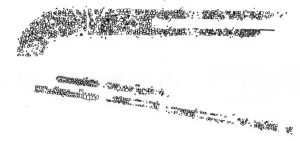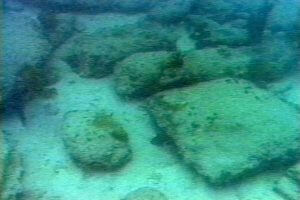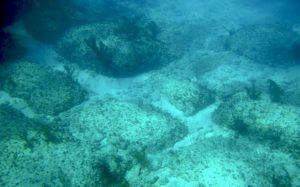
Abaddon
 26. 04. 2024
26. 04. 2024



 4
4
 10. 04. 2024
10. 04. 2024

Near the Bahamas, there are mysterious stone-block structures underwater that have not allowed locals, scientists, mystics and sensitizers to rest for decades; they believe that these buildings are a remnant of an ancient continent where the mythical Atlanteans lived.
No one knows where and where the underwater Bimin Road, located at the bottom of the Atlantic Ocean, leads. It is composed of large stone slabs, some of which are up to six meters long. They are laid at a depth of 3 to 9 meters, but due to the transparency of the water, they can also be seen at sea level. The total length of the road is 500 meters and a width of 90.
View from a bird's eye view
This mysterious "road" was discovered by a sports pilot. The rich American flew over his private plane above the water surface when his view suddenly caught a strange underwater structure. It was not like the submarine rocks, and the pilot thought it might be a city flooded several thousand years ago.
 All the more so because the American was well acquainted with the work of his compatriot, the clairvoyant Edgar Cayce, who had already predicted in 1936 that the ruins of ancient Atlantis would be discovered near the Bimini Islands between 1968 and 1969. According to Plato, it should have been flooded 12 years ago.
All the more so because the American was well acquainted with the work of his compatriot, the clairvoyant Edgar Cayce, who had already predicted in 1936 that the ruins of ancient Atlantis would be discovered near the Bimini Islands between 1968 and 1969. According to Plato, it should have been flooded 12 years ago.
This report has, of course, caused a general uproar and crowds of scientists and divers have headed for the Bahamas. The bottom off the island of North Bimini was examined by a doctor Manson Valentine from the Miami Museum of Natural History. During one of the dives, he discovered hundreds of rectangular stone slabs, paved paths and unusual structures of stone blocks in the form of columns, which were covered with a stone slab, at a depth of three meters.
Dr. Valentine described the object at the bottom of the ocean as a wide path of rectangular flat stones of various sizes, the edges of which were rounded by the long exposure of seawater. He was also convinced that they were of artificial origin.
Then a group of scientists from the University of Massachusetts took aerial photographs of the water surface and created a rough diagram of the distribution of mysterious objects. All indications were that the remains of an ancient road or the foundations of buildings and walls had been discovered. And maybe it was the top of the houses protruding from the age-old deposits at the bottom of the ocean.
Concerns have arisen about the origin of the stone blocks on the seabed. Some were convinced that this finding confirmed the existence of Atlantis. Researchers took samples of stones from Bimini for analysis and later reported that these blocks were not unusual broken off parts of coastal rocks, but worked stones. They even admitted the possibility that they could be made of a material similar to concrete.
According to another version, the Bimin stones are made of rock, a mixture of various minerals, which is composed of cobblestone and limestone, but such a species does not occur in the Bahamas. In addition, the researchers also showed stones on which protrusions and depressions interlocking are visible. The fact that some of them have a smooth surface, smoothed like a table top, speaks in favor of the theory that blocks are machined.
Nature can not so carefully adjust the stone, it is only capable of man, but only with the use of complex tools, supporters of the artificial origin of the journey think. The sampled samples were sent to the lab and it turned out that their age is not 12 - 14 for a thousand years, but they are twice as old.
And yet many still believe that the Biminská Road is composed only of strangely spaced rocks and cliffs. Geologist Eugene Shinn believes that the "way"  could be caused by tides. Later, a version of the origin of the "path" from the shells of marine animals was presented, which were pressed into a rectangular shape together with sand over the centuries.
could be caused by tides. Later, a version of the origin of the "path" from the shells of marine animals was presented, which were pressed into a rectangular shape together with sand over the centuries.
Others believe that man-made stone blocks are a discarded burden from naval ships. But how then to explain their concentration in one place and their distribution on the seabed so that they form a straight line, resembling a road?
The expeditions they tried to explore the journey to Atlantis were not successful. Not a single archaeologist diver managed to dig into the foundations of the stone blocks, prevented by strong underwater currents and eddies. In addition, the local waters are full of white sharks, the most dangerous for humans, and the bottom is teeming with moray eels. After the two expeditions in these places disappeared without a trace, the enthusiasm of underwater archaeologists somewhat waned.
The mysterious phenomena
Over time, legends and stories began to emerge around the mysterious journey, from which they froze. Two American divers surveyed in 1979 suffocated to see a glowing triangular object underwater with a "wingspan" span of about 12 meters. The triangle made several sharp turns over the bottom, emerged from the water, headed for the sky, and disappeared. This object was also seen by people on a boat waiting for divers.
In June 1998, a French expedition observed a bluish glow from the seabed in the North Bimini area, a wide strip with clear edges.
The light did not stay in place, but it moved, this strange glow lasting roughly 40 minutes, and its source failed to appear. As it turned out later, shining  the band also saw fishermen and the US space satellite also recorded it.
the band also saw fishermen and the US space satellite also recorded it.
But the most incredible story told by diver, John March:
In 2000, he allegedly saw a dark human figure underwater walking on ancient stone slabs. Marche was very surprised that the man was without a spacesuit, was about 3 meters high and was moving towards the diver, but he did not hesitate and emerged at the yacht that was waiting for him.
These bizarre stories are, of course, not documented, but the findings of the expedition of researcher Greg Little, in 2003 and 2004, make us think. Little and his team discovered that below the top layer of the stone blocks is another, the same, and even lower is the third layer. But they did not manage to get to the basics of the construction. They concluded that this was not a path, but the top of walls buried under sediments.
When examining a small part of the second layer, which was affected by water erosion to a lesser extent, it was found that the boards are thoroughly ground and fitted. The devices have shown that in the area paths they are below the bottom of the cavity and have detected the presence of metal, which is very unusual in these places, because there are no ore deposits either in the Bahamas or on the nearby mainland coast.
So what is really at the bottom of the ocean remains a mystery for now. The government of the Bahamas has already invested $ 800 million in a resort and research center near the ruins and capital, Nassau. And here come divers from all over the world with the main goal - to find Atlantis.